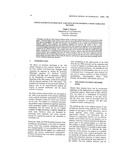Finite elements in practice: a review of engineerin's most versatile method

View/
Date
1999Author
Kanyeto, O.J.
Publisher
University of BotswanaRights holder
University of BotswanaType
Published ArticleMetadata
Show full item recordAbstract
Advantages of using Finite Element Method (FEM)in structural engineering practice are presented in this paper.A brief description of the method is given with the aim to illustrate the rich solid mathematical basis that makes its foundation.The paper then presents some guidelines on how to build a good model for Finite Element Analysis (FEA) purposes. The guideline emphasises the need for the analyst to have a clear understanding of the physical problem and of the behaviour of the elements he employs to carry out the analysis.A practical example presented in order to illustrate the type of analysis and results that can be obtained from a commercial FE software package. This example forms part of the research work that was carried out by the author.And finally, it is recommended that all practicing structural engineers must learn the basics of finite element method, and be equiped with some FE software packagess. Since it is the most commonly used and trusted method in the world of engineering today. In order to keep up with the rest of the world in engineering advancements, the author finds it vital to equip all engineers with the latest engineering software packages and to elevate continuing engineering education.
